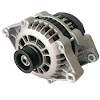Types of insulator
In successful operation of Overhead transmission system is mainly depends on proper selection of insulators. Depending upon the operation voltage and their properties the insulators are mainly of following types, namely
1. Pin type insulator2. Suspension type insulator
3. Strain insulator
4. Shackle insulator
1. Pin insulator:
The pin type insulator. In this insulator a groove is provided
on the upper (or) top portion of insulator for housing the conductor. The conductor
passes through this groove and is bound by the annealed wire of the same
material and is as show in fig.
Features PIN Insulator:
i) Pin type insulator are mainly used up to 33kv
for both transmission and distribution of power.
ii) Beyond
33kv the size of the PIN insulators become too bulky and hence uneconomical.
iii) The
factor of safety is about 10 and hence flash over takes place before the
insulators gets punctured.
iv) In pin
type insulators in order to increase the flashover voltage between between the
power conductor and the insulator the insulator is provided with multiple
petticoats and is as shown in 3.25 (i).
v) This type
of insulators are greatly effected from lighting as compared with suspension
insulators.
2. Suspension Type insulator
The cost of
pin type insulator is uneconomical at higher operating voltage beyond 33kV
suspension type insulators are are used.
It mainly
consists of number of porcelain discs connected inseries by metal links in the
from of a string. The conductor is suspended at the bottom end of the string
while the other end of string is connected to the cross-arm of tower and is as
shown in Fig. 3.26.
Features of Suspension Type Insulator:
(i) Each
disc of suspension type insulator is usually designed to 11kV. Depending upon
the working voltage, the desired number of discs are connected in series.
(ii) Suspension
type insulators are cheaper than pin type insulators for voltages beyond 33Kv.
(iii) These
insulators provides greater flexibility to the transmission line.
(iv) In
case increase in demand it is easy to add an additional number of discs due to
raise in working voltage.
(v) This
type insulators are generally used with steel towers.
(vi) As
the conductors are run below the earthed cross-arm of the tower the effect of
lightning is reduced.
(vii) If
any one disc is damaged, the whole string does not become useless because the
damaged disc can be replaced by new one.
(viii) The
disc of suspension insulators are used in horizontal plane.
3. Strain Insulator
This type of insulators are manly
used when the transmission line is subjected to greater tension at points of
dead end of the line, corner and curved shapes.
It is very similar to suspension
insulators, but in this type the whole arrangement of insulators are used in
vertical plane as shown in Fig.
Features of Strain Insulator:
(i) Each
disc of strain insulator are designed to 11 Kv.
(ii) This
type of insulators are very economical beyond 11 kV as compared to shackle
insulators
(iii) In
case of increase in demand, it is easy to add an additional number of discs due
to rise in operating voltage.
(iv) The
discs of strain insulators are used in vertical plane.
(v) If
any discs is damaged, than whole arrangement is not useless because the damaged
disc can be replaced easily by new one.
4. Shackle Insulators
This type of insulators are mainly used when the distribution
lines are subjected to greater tension at the points of dead end, corner and
curved shapes.
This type of insulators are placed either in horizontal
position (or) in vertical position. This type insulators are directly fixed to
the pole with a bolt (or) to the cross arm.
Fig. 3.28 shows shackle insulator fixed to the pole and cross
arm. A groove is provided in the insulator for placing the conductor which is
fixed with a soft binding wire as shown in Fig. 3.28.










0 Comments